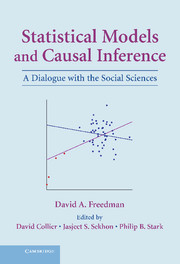Book contents
- Frontmatter
- Contents
- Preface
- Editors' Introduction: Inference and Shoe Leather
- Part I Statistical Modeling: Foundations and Limitations
- Part II Studies in Political Science, Public Policy, and Epidemiology
- Part III New Developments: Progress or Regress?
- 12 On Regression Adjustments in Experiments with Several Treatments
- 13 Randomization Does Not Justify Logistic Regression
- 14 The Grand Leap
- 15 On Specifying Graphical Models for Causation, and the Identification Problem
- 16 Weighting Regressions by Propensity Scores
- 17 On the So-Called “Huber Sandwich Estimator” and “Robust Standard Errors”
- 18 Endogeneity in Probit Response Models
- 19 Diagnostics Cannot Have Much Power Against General Alternatives
- Part IV Shoe Leather Revisited
- References and Further Reading
- Index
18 - Endogeneity in Probit Response Models
Published online by Cambridge University Press: 05 June 2012
- Frontmatter
- Contents
- Preface
- Editors' Introduction: Inference and Shoe Leather
- Part I Statistical Modeling: Foundations and Limitations
- Part II Studies in Political Science, Public Policy, and Epidemiology
- Part III New Developments: Progress or Regress?
- 12 On Regression Adjustments in Experiments with Several Treatments
- 13 Randomization Does Not Justify Logistic Regression
- 14 The Grand Leap
- 15 On Specifying Graphical Models for Causation, and the Identification Problem
- 16 Weighting Regressions by Propensity Scores
- 17 On the So-Called “Huber Sandwich Estimator” and “Robust Standard Errors”
- 18 Endogeneity in Probit Response Models
- 19 Diagnostics Cannot Have Much Power Against General Alternatives
- Part IV Shoe Leather Revisited
- References and Further Reading
- Index
Summary
Abstract. Endogeneity bias is an issue in regression models, including linear and probit models. Conventional methods for removing the bias have their own problems. The usual Heckman two-step procedure should not be used in the probit model: From a theoretical perspective, this procedure is unsatisfactory, and likelihood methods are superior. However, serious numerical problems occur when standard software packages try to maximize the biprobit likelihood function, even if the number of covariates is small. The log-likelihood surface may be nearly flat or may have saddle points with one small positive eigenvalue and several large negative eigenvalues. The conditions under which parameters in the model are identifiable are described; this produces novel results.
Introduction
Suppose a linear regression model describes responses to treatment and to covariates. If subjects self-select into treatment, the process being dependent on the error term in the model, endogeneity bias is likely. Similarly, we may have a linear model that is to be estimated on sample data; if subjects self-select into the sample, endogeneity becomes an issue.
Heckman (1978, 1979) suggested a simple and ingenious two-step method for taking care of endogeneity, which works under the conditions described in those papers. This method is widely used. Some researchers have applied the method to probit response models. However, the extension is unsatisfactory.
- Type
- Chapter
- Information
- Statistical Models and Causal InferenceA Dialogue with the Social Sciences, pp. 305 - 322Publisher: Cambridge University PressPrint publication year: 2009

